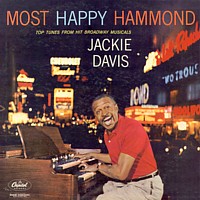Home · Listener's Guide · The Songs · Who's Who · Liner Notes · Selected Tracks · What's New · Search

Jackie Davis
- Born Jackson J. Davis, 13 December 1920, Jacksonville, Florida
- Died 15 November 1999, Jacksonville, Florida
 Jackie Davis was the first musician to popularize jazz on the Hammond organ, years before Jimmy Smith's name became synonymous with organ jazz. Davis was Capitol's leading performer on the organ at a time when relatively few mainstream labels were willing to put a black musician on the cover of an album.
Jackie Davis was the first musician to popularize jazz on the Hammond organ, years before Jimmy Smith's name became synonymous with organ jazz. Davis was Capitol's leading performer on the organ at a time when relatively few mainstream labels were willing to put a black musician on the cover of an album.
Davis once said that music came to him genetically. His mother played the washtub, a cheap substitute for the bass, and he first learned to play by spending hours poking at his grandmother's piano. By the age of eight, he was playing with a local dance band. The rest of the band had ten years or more on him, and he later remarked that he had "eighteen godfathers who kept their pedal extremities in sensitive areas of my anatomy." He later described the experience as his best education in music and in life. By the age of eleven, he'd earned enough from playing to buy his own piano, and music enabled him to pay his way through Florida A&M College, where he graduated with a bachelors degree in music in 1943.
After serving time in the Army, he worked as a pianist, usually as an accompanist for singers such as Dinah Washington, Sarah Vaughan, and Billy Daniels. Although he was attracted to the organ, he was intimidated at the prospect of playing jazz on it, particularly when his idol at the time was the lightning-fast Art Tatum. But when the Hammond Organ Company began selling electric organs in the late 1940s, he felt the biggest technical hurdle had been overcome, and in 1951, he bought his first organ. Soon after, he was hired to appear at the Club Harlem in Philadelphia, and the novelty of Davis' playing on the Hammond was so remarkable that the club extended his two-week gig by almost five months.
RCA signed him to record a couple of 45 RPM singles, but they were still a bit too lily-white to invest in an album. A year later, a small New York City label, Trend, released a 10" album that was later reissued by Kapp Records. It was still tough to make a go as a solo performer, though, and in 1952, Davis accepted an offer from Louis Jordan to play in his band. He spent over a year with Jordan and learned a great deal about stage presence and connecting with an audience from the ebulliant band leader.
Finally, in 1956, Capitol Records A&R exec Bill Miller convinced the label to sign Davis to a contract. The first album, Hi-Fi Hammond sold well in white markets, and over the next five years, the label released eight more albums by him. His material was usually light, jazzy interpretations of standards, usually in a small combo setting, just rhythm guitar and drums backing him up. Miller only veered from this formula on a couple of occasions. One was with an unusual accompaniment of nine trombones and one trumpet, arranged by Gerald Wilson, and the other the obligatory cha-cha album with Milt Holland providing a variety of Latin percussion accents.
Davis was lured over to Warner Brothers Records around 1961, after former Capitol and Columbia president Jim Conkling established the label and attempted to "out-normal" the other labels in a period well-covered in Stan Cornyn's book, Exploding. His first Warner release, Easy Does It is probably his best, with Hollywood's best session guitarist, Barney Kessel, lending his support. His second release, featuring a thick layer of syrupy vocal accompaniment, is of interest neither as organ jazz nor choral music. Warner dropped Davis as they cleared their books of space age pop acts in favor of the Everly Brothers and other white rockers, and, with the exception of an occasional minor label release, his recording career was over.
He soldiered on for the next 30 years, playing clubs ranging from Las Vegas to Atlantic City and everything from jazz festivals to restaurants. In 1978, while he was producing Ella Fitzgerald records at the rate of about two a month, Norman Granz hired Davis to accompany her, along with Louis Bellson on drums, on her album, Lady Time. He was an annual fixture at a club in Hilton Head, South Carolina, through much of the 1980s. When Hurricane Andrew devastated south Florida in 1992, Davis suffered financially and physically. His home was wiped out, and the strain of the experience led a series of strokes and heart attacks. He had recovered sufficiently by 1997 to start performing again, with a new manager trying to hook into the lounge music revival. His health didn't hold up, however, and he died in 1999 in a nursing home in his home town of Jacksonville.
You can find out more about his life and music at www.jackiedavis.info, a nice site created by Dutch fan Wim de Haan.
Recordings (Courtesy of Dave Roemersberger)
- The Jackie Davis Trio, Trend LP-1010 (10"LP)
- The Jackie Davis Trio Organistics, Kapp KL-1030
- Hi-Fi Hammond, Capitol T-686
- Chasing Shadows, Capitol T-815
- Jumpin' Jackie, Capitol T-974
- Most Happy Hammond, Capitol T-1046
- Jackie Davis Meets The Trombones, Capitol T-1180
- Hammond Gone Cha-Cha, Capitol T-1338
- Tiger On The Hammond, Capitol T-1419
- Hi-Fi Hammond Vol.2, Capitol T-1517
- Big Beat Hammond, Capitol T-1686
- Easy Does It, Warner Bros. W-1492
- Jackie Davis Plus Voices, Warner Bros. W-1515
- The Sacred Side Of Jackie Davis, Brunswick BL-754143
- Jackie Davis Plays The Park Plaza, RCA Victor PC/PCS-1061
- Here's Jackie, KM Kei-Mar Records (No Record Number)
- Jackie Davis Entertains, Columbia Canada EL-112
- Ambiance, EMI (France) 2C04850704
- After Hours With Miss D, (Jackie Davis Accompanies) Verve 800000094-02 (CD)
- Lady Time, (Ella Fitzgerald, Jackie Davis, Louis Bellson) Pablo OJCCD-864-2 (CD)
- The Story Of Jazz, EMI PLus 724357621526 (CD)
Search for Records and CDs
New CDs from Amazon.com
Used Records and CDs from GEMM.com
S p a c e A g e P o p M u s i c
Home · Listener's Guide · The Songs · Who's Who · Liner Notes · Selected Tracks · What's New · Search
Email: editor@spaceagepop.com